Educational and Research Base for Fusing Engineering and Aesthetics to Propose Design of the Next Generation
-Putting Emphasis on Visualization Education, the Dept. Has Started to Use 3D-VR to Examine Urban and Regional Renovation-
Not a few people may have heard a college song of Hosei University with its impressive refrain, "Hosei, our old school". Then, do you know that there is a phrase which means "Fireflies will gather in the Outer Moat at the gate" in the song?
Founded nearly 130 years ago, Hosei University boasts of its long history. This issue focuses on "Dept. of Civil and Environmental Engineering" in Faculty of Engineering and Design, which was newly established last year to reflect needs of the times, and on "Laboratory of Regional Design with Ecology" in Graduate School of Hosei University.
Dept. of Civil and Environmental Engineering places an emphasis on visualization education. As a part of it, a visualization system for reinforced concrete structures has been created by faculties of material-related studies and others. It was originally designed to make students have experiences with a view point of walking through a reinforced concrete structure itself, as well as to make it serve for designing bridges etc. At the same time, Prof. Kiyoe Miyashita, full-time lecturer of the Dept. paid attention to "UC-win/Road", a 3D real-time VR (Virtual Reality) software product by Forum 8, as a tool to represent completed images of the bridge and reflect various proposals. After being installed for the original purpose, it was used for wider ranges of usages, such as studies of renovation of the Outer Moat and its surrounding urban area, and then creation of 3D-VR data of the urban area along the Nihonbashi River. One thing that has triggered off such a development is the features of the tool capable of representing even "fireflies" quoted at the opening in VR at the stage of examining plans, as Mr. Miyashita looks back.
So, we interviewed Prof. Kiyoe Miyashita, who paved the way for introducing "UC-win/Road", along with Professor Hidenobu Jinnai of Dept. of Architecture of the same Faculty, Professor Kenichi Takahashi of Dept. of Civil and Environmental Engineering, Mr. Daisuke Sakurai, Senior student of the Dept, Mr. Shigenao Onda, Researcher at Ecological Regional Design Laboratory of the Graduate School, Mr. Takafumi Akashi, Map Concierge of the same Laboratory, as 6 key persons of the whole process including the subsequent developments.
"A university must challenge the new age, always reviving as an educational and research institute." (Prof. Hidenobu Jinnai)
Hosei University originates from Tokyo Hogakusha, which was founded in 1880 (Meiji 13). In 1920 (Taisho 9), when it restarted under the current school name according to the new University Order, it consisted of Law and Economics Faculties. Then, in expanding its organization as a university, Faculty of Engineering was established in 1950 (Showa 25) by reorganizing Hosei University Aviation Industry Technical School (founded in 1944), following the Educational Reform. In 1964, Faculty of Engineering moved to Koganei Campus, when universities tended to leave the metropolitan center for suburban areas. Since then, reflecting changes of surrounding environments and rapid technological innovation, the Faculty has been repeating establishment and reorganization of departments. Consequently, it has expanded both in quality and quantity from the original 4 departments (Mechanical Engineering, Electrical Engineering, Construction Engineering, and Industrial Engineering) to 10 departments (Mechanical Engineering, Materials Chemistry, Electronics, Electrical and Computer Engineering, Electronics Informatics, System Control Engineering, Industrial engineering, Frontier Bioscience, Architecture, Civil and Environmental Engineering, and System Design) . In the mean time, faculty structure of the Hosei University as a whole has expanded to have 12 faculties as of 2007 academic year, with additional 3 faculties to be newly established in April 2008. Around 30,000 students of both Undergraduate and Graduate Schools are learning in 3 campuses of Ichigaya , Tama, and Koganei in total (44,000 in total including Professional Schools, School of Correspondence Education, and the affiliated Junior/Senior High School).
On the other hand, in recent years, there has been a tendency to reevaluate City Core that is filled with the latest information or intellectual stimulation as a place for university education once again. Considering that "urban space is a place for education in itself," especially for the students of architecture or design, 3 departments (Architecture, Civil and Environmental Engineering, and System Design) were reorganized. Then Faculty of Engineering and Design was established in April 2007.
As an interim measure, for the students of the above mentioned 3 departments, juniors and seniors of 2008 academic years are distinguished from freshmen and sophomores who entered the Faculty under the new system (as Faculty of Engineering and Design) as to where they belong to. Therefore, professors and lecturers whom we interviewed teach at both Faculties for the time being. Along with this, reconstruction of ’62 Building (in Ichigaya Campus) is progressing to serve as the base for Faculty of Engineering and Design to evolve in and around the city center. The new school building with its function and design renewed (with five stories above and one under the ground) is to be available from this coming April, when freshmen are expected to join.
The research subjects of "Dept. of Civil and Environmental Engineering", renamed in 2004 from Dept. of Civil Engineering which was originally related with Dept. of Construction Engineering, cover 6 areas in 3 types of program, namely, Environmental System (hydraulics & environment and ground environment), Urban Planning (urban planning and space information), and Facility Design (facility structure and facility materials).
Prof. Miyashita studies IT (information technology) such as GIS (geographical information system), remote sensing, or VR in connection with statistical process among others. As a part of this, he has been studying with emphasis on renovation of the Outer Moat and its surrounding urban area, triggered by establishment of Dept. of Civil and Environmental Engineering in Ichigaya Campus as mentioned above.
In concrete, from a view point of regenerating with water and green, green space distribution around the Outer Moat was extracted based on the image data shot by an artificial satellite (Quick Bird). Laying other data such as buildings (fireproof structures between 5 and 12 stories) using GIS on top of it, possibilities of forming a green network by rooftop gardening etc. have been explored from various angles. Through these attempts, an idea took shape that several proposals, which went through accumulated examination, should be represented in VR, simulating an approach towards regional renewal where fireflies flutter about on the Outer Moat, as described in the school song in the opening.
It was Mr. Daisuke Sakurai who played a leading role in representing these concepts with 3D-VR using "UC-win/Road".
The first plan that came out first for changing the shape of the Outer Moat was that of constructing a new bridge at Shin-Mitsukebashi, aiming at water purification as well as unification of Ushigome Moat and Ichigaya Moat. Some bridge forms were simulated for this plan. Various design plans other than this have been visualized, such as creation of a water garden by filling in the Outer Moat, creation of a multi story park including facilities of JR (Japan Railway) that runs adjacent to the moat, or wall greening that considers measures for heat island phenomena.
Partly because a series of data were elaborately created, their product received an honorable judge award (Art Award) at the 6th 3D-VR Simulation Contest (sponsored by FORUM 8) held on November 21, 2007. The data have also been utilized for a survey conducted on students and various events within the University. However, as it took long time to complete the work, no examination was made for its usability as a tool for consensus building to be used in presentation to the local town planning council etc. It is considered to be an assignment for the years to come.
| "VR Simulation Around Ichigaya Campus of Hosei University" Received Honorable Judge Award (Art Award) at the 6th 3D-VR Simulation Contest by UC-win/Road. Research is conducted from ecological and historical points of view in order to renovate the Outer Moat and its surrounding area in a sustainable and unique setting, along with the development of Faculty of Engineering and Design in Ichigaya Campus. VR data centering on the Outer Moat were created with high precision, and VR was created aiming at revitalization in line with a phrase in the college song "Fireflies will gather in the Outer Moat at the gate" as a symbol of renovation. The VR is planned to be used widely for publicity of the Department as well as for a teaching material. |
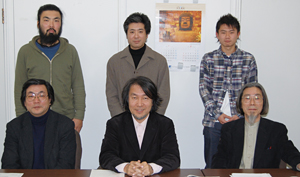 |
||
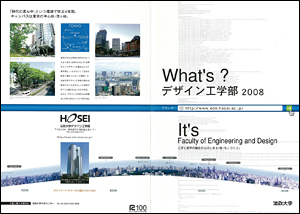 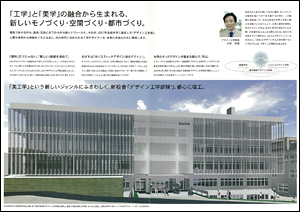 |
||
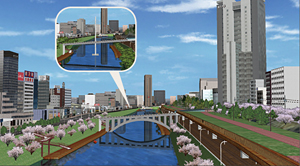 |
||
>> " VR Simulation Around Ichigaya Campus of Hosei University" Received Honorable Judge Award (Art Award) at the 6th 3D-VR Simulation Contest by UC-win/Road. |
||
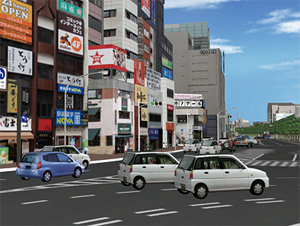 |
||
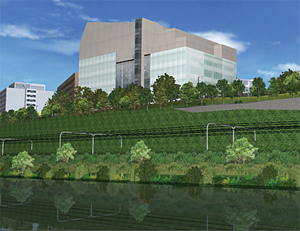 |
||
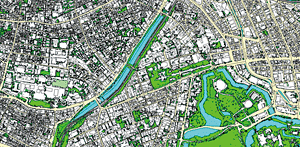 |
||
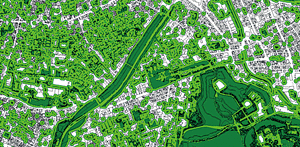 |
||
In 1965, 15 years after Department of Engineering started, Hosei University established Graduate School of Engineering. The School currently consists of 6 majors: Mechanical Engineering, Materials Chemistry, Electrical Engineering, Information Electronics Engineering, Civil Engineering and Architecture, and System Engineering. Civil Engineering and Architecture is divided into the Urban Environmental Design Engineering Field and the Architectural Field.
Moreover, "Laboratory of Regional Design with Ecology, Graduate School of Hosei University" (Director: Professor Hidenobu Jinnai) was formed in 2004 so that different experts who study problems about cities and environments in Hosei University could carry out cross-sectional studies across the whole organization. The Laboratory holds up its concept that it aims at urban and regional planning in the 21st century with water and environments as its core by "connecting ecology and history" and "promoting interactions between western and eastern wisdomes". Since then, in conducting one specific job after another, they came to pay attention to the importance of reconnecting river basins ranging from headwaters to the sea as a total and organic system. They not only collaborate with groups that keep on independent activities in their own communities or conduct various events, but have also been putting emphasis on visualization of their research products in order to present them in an easy way to understand.
On the other hand, the Lab started to make research in 4 groups, including "history", "ecology", "regional management", and "revitalization" according to each research field. However, this rather caused the organization to become self-sufficient with vertical sectionalism, resulting in a situation hard to produce dynamic interaction that was originally sought. Consequently, this system was switched in 2006 so that a project would be organized according to the characteristics of a subject and addressed in cooperation across different fields. Moreover, since 2007 academic year, new research system has been adopted that makes it easier to bring together results of each specific research field, taking account of reaction to "Global CEO Program" by Ministry of Education, Culture, Sports, Science and Technology. The efforts towards revitalization of the Outer Moat mentioned above are integrated in the process of this "City Core and Bay Area Renovation Project".
In relation to this, Prof. Kenichi Takahashi expresses his opinion that "Water system in city core can be traced up to the headwaters. If so, in considering regeneration of city core, its relation with the upper basin should be put in order." Therefore, in "Basin Zone Renovation Project" of which he is a leader, he has positioned Hino Irrigation Channels or Musashino Tableland as the main fields. Especially the area around Kokubunji Cliff Line that characterizes Musashino Tableland is a big-boned green zone, which should be conserved as a "historical and ecological corridor" for its importance, as he explains.
Furthermore, "Society for the Research of Waterfront Spaces in Tokyo" is working on creation of 3D-VR data of urban areas along the Nihonbashi River with Mr. Shigenao Onda, Researcher and Mr. Takafumi Akashi as its leading members. For there are more and more debate about whether the Tokyo Metropolitan Expressway should be removed from the Nihonbashi River, research has been carried out to grasp the present situation about the spaces along the Nihonbashi River, where there are a lot of historical remnants such as great bridges or architecture, since last spring. In the beginning, they created data on 2D basis from all the successive elevations. Then, they saw the presentation about renovation of the Outer Moat using 3D-VR, when they were convinced of availability of VR. As the research section of the Nihonbashi River was about 4 km long, there was a concern that it would be massive work to represent it in CG just like architecture. Mr. Shigenao Onda says that it was assumed that using VR, it would be comparatively easier to make 3D representation with light data. The Society is currently carrying on creating the data, and willing to exhibit them at an exhibition within the University to be held in the middle of April.
Similarly, Prof. Hidenobu Jinnai and Prof. Kenichi Takahashi say that they started to take positive position towards using 3D-VR after looking at the presentation on the Outer Moat renovation. Moreover, Prof. Miyashita thinks that there should be more and more needs for VR as a tool for building consensus or collaboration among engineers, while expecting from it a function to superpose with more diverse GIS data.
We are most grateful to everyone involved for spending time with us for the interview.
